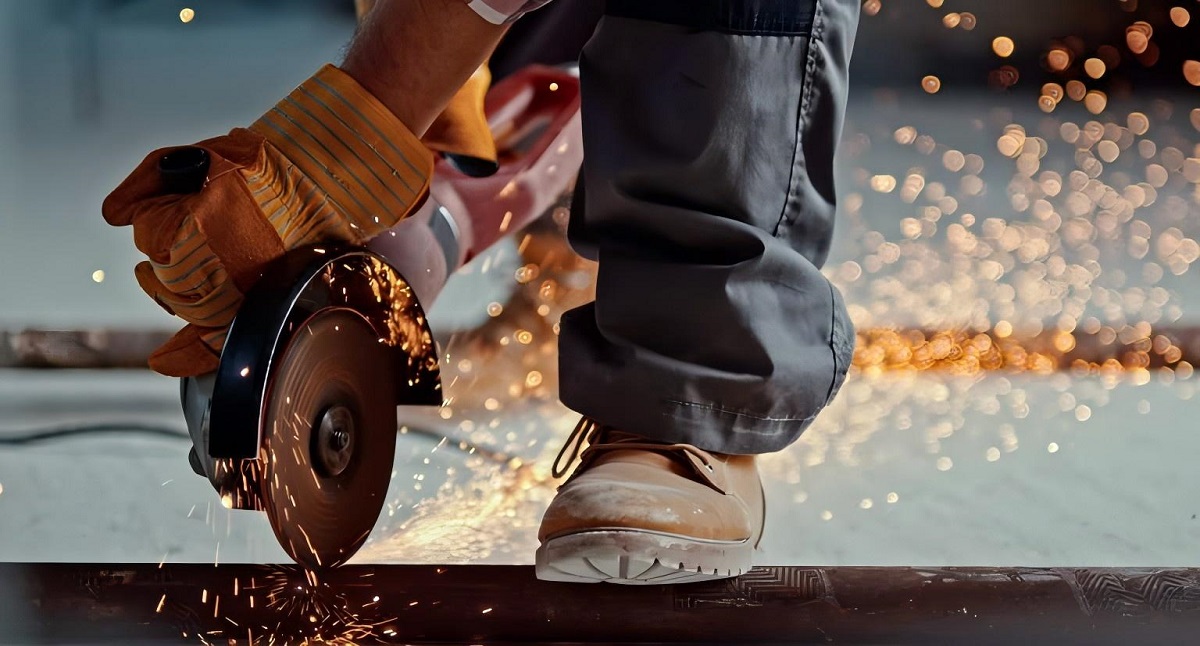Cutting a straight line with an angle grinder can seem like a daunting task for beginners, but with the right technique and tools, it can be done precisely and efficiently. Angle grinders are versatile power tools used for cutting, grinding, polishing, and sanding a wide variety of materials, including metal, concrete, and stone. However, one of the most common challenges is cutting straight lines, especially when precision is key.
In this guide, we’ll walk you through the entire process of cutting a straight line with an angle grinder, covering the tools you’ll need, safety precautions, and step-by-step instructions.
Tools and Materials You’ll Need
Before you begin, make sure you have the following tools and materials on hand:
- Angle Grinder: Choose an angle grinder that suits the material you’re cutting. A 4.5-inch grinder works well for most tasks, while a 7-inch or larger grinder may be better for heavy-duty cutting.
- Cutting Disc/Wheel: Use the appropriate cutting disc based on the material you’re working with. Metal cutting discs are thin and work well for metal, while diamond-tipped blades are ideal for concrete, stone, and tiles.
- Clamp or Vise: You need to secure the material you’re cutting to ensure stability while you work.
- Straightedge or Guide: A straight edge or a piece of metal/aluminum can serve as a guide to help keep your cut straight.
- Marker or Chalk: This will be used to mark the cutting line.
- Safety Gear: Safety is paramount when using an angle grinder. Wear the following:
- Safety goggles
- Hearing protection
- Dust mask or respirator (especially when cutting materials like concrete or stone)
- Thick work gloves
- Long-sleeved shirt and pants to protect your skin
Safety First: Precautions When Using an Angle Grinder
Angle grinders are powerful tools, and if not used correctly, they can be hazardous. Follow these safety tips to ensure a safe work environment:
- Check the Grinder and Discs: Ensure the angle grinder is in good working condition, and always check the cutting disc for any cracks or defects before using it.
- Secure Your Material: Use clamps or a vise to hold your material in place, preventing it from moving during cutting. This will not only improve the accuracy of your cuts but also reduce the risk of accidents.
- Keep a Firm Grip: Always use both hands to control the grinder, and maintain a firm grip at all times.
- Cut in a Well-Ventilated Area: Angle grinders can create a lot of dust and debris, especially when cutting materials like concrete or stone. Ensure you are working in an open or well-ventilated space.
- Stay Focused and Patient: Avoid rushing. Patience and precision are crucial to making a straight cut.
Step-by-Step Guide to Cutting a Straight Line with an Angle Grinder
Now that you’re equipped and aware of the safety guidelines, let’s move on to the steps required to cut a straight line with an angle grinder.
Step 1: Prepare the Workspace and Materials
Before you start cutting, clear the workspace of any obstructions, tools, or debris. Lay out the material you’re cutting on a sturdy surface, such as a workbench, and ensure it is securely clamped or held in place by a vise.
Step 2: Mark the Cutting Line
Use a marker, pencil, or chalk to mark a straight line where you want to cut. Accuracy here is key, so take your time to ensure the line is straight. If possible, use a ruler or a straightedge to guide your line.
For longer cuts, using a guide like a piece of metal, wood, or even a level clamped onto your material can help ensure the grinder follows a straight path. You can also use masking tape along the line to provide a visual guide.
Step 3: Install the Correct Disc
Install the cutting disc appropriate for the material you’re working with. If you’re cutting metal, use a thin metal-cutting disc. For stone, concrete, or tile, use a diamond cutting disc.
Ensure the disc is tightly secured to avoid wobbling, which can lead to an uneven cut. Always check the manufacturer’s recommendations for the maximum RPM rating of the disc and match it to the angle grinder’s speed.
Step 4: Position the Angle Grinder
Hold the angle grinder with both hands, one on the main handle and the other on the support handle. Position the grinder so that the cutting disc aligns with the marked line.
Begin by positioning the cutting disc at one end of the line, slightly above the material’s surface. Hold the grinder at a 90-degree angle for a straight cut and ensure the blade is perpendicular to the surface.
Step 5: Start the Cut
Turn on the angle grinder and allow it to reach full speed before making contact with the material. Start by lightly scoring the surface of the material along the marked line. This creates a shallow groove that will serve as your guide for the deeper cut.
Take your time during this step to ensure accuracy. Don’t rush the cut, and allow the disc to do the work. Forcing the grinder may cause the disc to bind or break.
Step 6: Deepen the Cut
Once you’ve scored the line, you can deepen the cut by making multiple passes over the same line. Gradually apply more pressure with each pass, but avoid pushing too hard, as this could cause the disc to overheat or bind.
For thicker materials like metal or concrete, cutting in layers is essential to maintain control and prevent the blade from binding or overheating.
Step 7: Follow the Guide
If you’re using a guide or straight edge, ensure the grinder remains in contact with it throughout the cut. This will keep the grinder aligned and help you maintain a straight line.
Avoid the temptation to lift the grinder or cut too quickly. Slow, controlled movements ensure a cleaner and straighter cut.
Step 8: Finish the Cut
As you approach the end of the cut, slow down to maintain control and avoid breaking or damaging the material. Once the cut is complete, turn off the grinder and allow the disc to stop rotating before setting it down.
Inspect the cut to ensure it is straight and clean. If any burrs or rough edges remain, you can smooth them out with a file or sanding disc attached to the grinder.
Tips for Cutting Straight Lines with an Angle Grinder
- Use a Guide: If you’re concerned about maintaining a straight line, use a guide or clamp a straightedge to your material to help the grinder follow a precise path.
- Score Before Cutting Deep: Lightly score the material along the cutting line before making deeper passes. This will help prevent the grinder from veering off course.
- Avoid Overheating: Prolonged cutting without breaks can cause the cutting disc to overheat and wear out prematurely. If you’re cutting thicker materials, give the grinder a rest between passes.
- Practice on Scrap Material: If you’re new to using an angle grinder, practice cutting straight lines on scrap pieces before working on your actual project. This will help you gain confidence and improve your technique.
- Use the Right Disc for the Job: Using the correct type of cutting disc for the material will make the process smoother and result in a cleaner, straighter cut.
Common Mistakes to Avoid
- Pushing Too Hard: Let the grinder do the work. Applying too much force can cause the blade to bind, break, or veer off course.
- Not Securing the Material: If the material isn’t clamped or held securely, it can move during the cut, leading to mistakes or accidents.
- Skipping the Scoring Step: Cutting straight into thick material without scoring first can cause the grinder to bounce or veer off the line.
- Inadequate Safety Gear: Never compromise on safety. Always wear protective gear to shield yourself from sparks, debris, and the potential hazards of the cutting disc.
Conclusion
Cutting a straight line with an angle grinder requires the right tools, a steady hand, and careful attention to detail. By following the steps outlined in this guide—along with a focus on safety and precision—you can achieve clean, straight cuts on a variety of materials. Whether you’re cutting metal, concrete, or stone, practice and patience are key to mastering this versatile tool.


